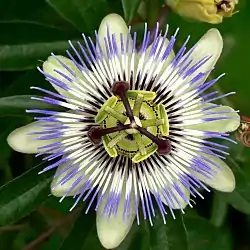時計草
Japanese

時計草 (tokeisō): a passionflower as seen from above, with the three parts of the pistil shown as the dark, thick arms extending from the center.
| Kanji in this term | ||
|---|---|---|
| 時 | 計 | 草 |
| とき > と Grade: 2 |
けい Grade: 2 |
そう Grade: 1 |
| irregular | on’yomi | |
Etymology
Compound of 時計 (tokei, “clock”, jukujikun (熟字訓)) + 草 (sō, “herb, plant”), so named because the shape of the flower is similar to a clock.[1][2] The pistil's three parts can be likened to the hour hand, minute hand, and second hand of a clock, as seen in the image.
References
- Shōgaku Tosho (1988) 国語大辞典(新装版) [Unabridged Dictionary of Japanese (Revised Edition)] (in Japanese), Tōkyō: Shogakukan, →ISBN
- Matsumura, Akira, editor (2006), 大辞林 [Daijirin] (in Japanese), Third edition, Tōkyō: Sanseidō, →ISBN
This article is issued from Wiktionary. The text is licensed under Creative Commons - Attribution - Sharealike. Additional terms may apply for the media files.